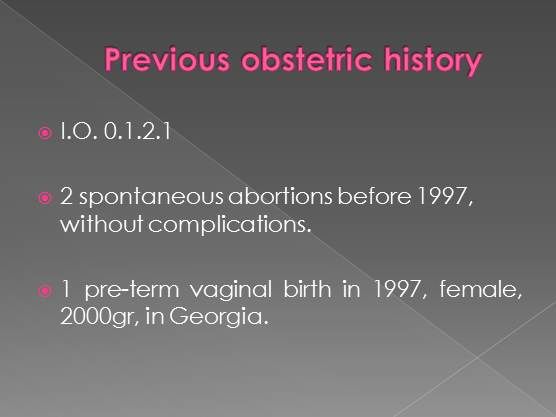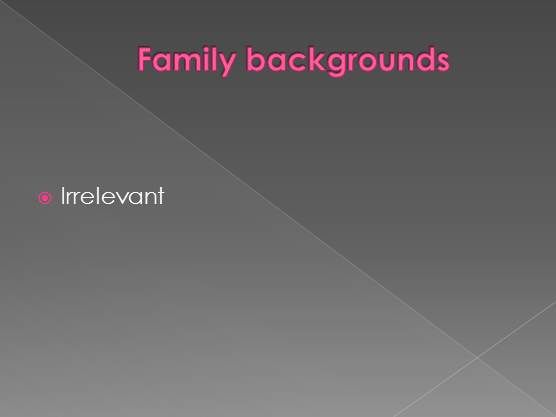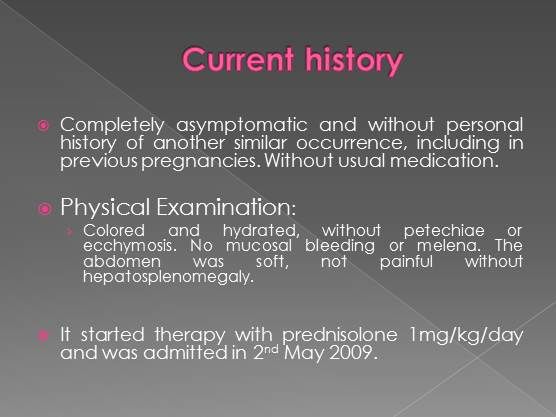Thrombocytopenia in Pregnancy A clinical case review


• I.G.,
• 35 years,
• GIVPI,
• Maried,
• One son,
• Natural from Georgia,
• Living in Portugal.

Severe thrombocytopenia

• Cronical Hepatitis C.
• No other relevant previous background.

• I.O. 0.1.2.1
• 2 spontaneous abortions before 1997,
without complications.
• 1 pre-term vaginal birth in 1997, female,
2000gr, in Georgia.

• Irrelevant

• Pregnant women of 34 weeks of gestation referred to
the emergency because of platelets count of
21.000/µL – 2nd May 2009.
• Actual pregnancy:
› Last menstruation:05/09/2008 EDD: 12/06/09.
› Uneventful - without ultrasound changes.
› Amniocentesis: normal cariotype 46,XY.
› Blood tests: immune to rubella and toxoplasmosis. AtgHBs, HIV
and VDRL negative. HCV positive. Concentration of platelets in
the first trimester of 120.000/µL.

• Completely asymptomatic and without personal
history of another similar occurrence, including in
previous pregnancies. Without usual medication.
• Physical Examination:
› Colored and hydrated, without petechiae or ecchymosis.
No mucosal bleeding or melena. The abdomen was soft,
not painful without hepatosplenomegaly.
• It started therapy with prednisolone 1mg/kg/day
and was admitted in 2nd May 2009.

• During the hospitalization she remained
asymptomatic and with normal blood pressure.
• Serologies were made with negativity for HBsAg, HIV
and VDRL, immunity to CMV and HCV viral loads
were minimum (34564 IU / ml).
• Normal kidney and hepatic function.
• Anti-nuclear and Anti-phospholipidic antibodies were
requested. They turned out negative. The antiplatelet
antibodies were also negative.

• The abdominal ultrasound revealed a liver with
regular shape and a large nodular calcification in
the right lobe (probably sequelae) and mild
homogeneous splenomegaly. No other changes
were encountered.
• On 9th May she was discharged with platelets
count of 48.000/µL and 60 +20 mg of prednisolone.

• She returned to the hospital for analytical
control in 13th May, at that time the
platelets count was 26.000/µL;
• Prednisolone was increased to initial
dosage – 60+30 mg;
• Poor adherence to therapy versus
unresponsive to treatment?

• On 20th May she entered in emergency
room in labour with amniotic rupture. At
that time platelets count was of 31.000/µL.
• Labour:
› 20th May at 13h19m with GA of 37 weeks.
› Vaginal birth, loose cervical circular and midlateral
right episiotomy.
› Masculine newborn, with 3470gr. Apgar 1’= 10.
› The newborn was discharged by the
pediatrician at the 2nd day of life without
complications.


• Definition: platelets count in peripheral
blood less than150.000/µL. It complicates
7 to 8% of all pregnancies.
• Categories:
› Light – 100000 a 150000/µL;
› Mild – 50000 a 100000/µL;
› Severe - <50000/µL.

• Frequent etiologys:
› Gestacional thrombocytopenia – 70% (70.000-100.000/µL);
› HELLP Syndrome – 21% (usualy platetlets count >20.000/µL <100.000/µL) – Blood
pressure rise and proteinuria can be absent;
› Idiopathic thrombocytopenic purpura (ITP) – 3% (5.000-75.000/µL).

• Other etiologies:
› Pseudothrombocytopenia - laboratory artifact due to the
presence of platelet aggregates;
› Microangiopathy - Trombotic Thrombocytopenic Purpura (TTP)
and hemolytic uremic syndrome (HUS);
› SLE and other autoimmune diseases
› Viral infections (particularly CMV and HIV);
› Hypersplenism;
› Medications (heparin, zidovudine, methyldopa);
› Massive obstetric hemorrhage and detachment of the placenta;
› Sepsis;
› Folate deficiency;
› Aplastic anemia;
› Allergy.

• Detailed clinical history of personal background including previous pregnancies, allergy and drug habits.
• Physical examination with y particular attention to equimoses, petechiae, mucosal bleeding, melena, kidney or neurological disorders. Measurement of blood pressure.
• Abdominal ultrasound - exclusion of splenomegaly and associated liver pathology;
• Analytical study:
› With blood platelets count and blood smear;
› Hepatic function / LDH / creatinine / BUN / total and direct bilirubin;
› Antinuclear and antiplatelet antibodies;
› Determination of folic acid;
› Serology for CMV and HIV.

• If platelets <50.000 and / or abnormal bleeding and / or invasive procedures (such
as cesarean section or locoregional anesthesia):
› Prednisolone 1mg/kg/day - in a slowly decreasing in order to maintain platelets count above 50.000 - response time of 3 to 7 days.
› Gamma-globulin 400mg/kg/day - ideal in cases where there is a need for immediate increase of platelets (response time of between 6-72h) such as a surgery or bleeding;
› Anti-D immunoglobulin – in pregnant women rh positive, non-splenectomized;
› Splenectomy - if in 1st or 2nd trimester with platelets count <10,000 and
refractory to steroids or gamma globulin;
• Platelets transfusion:
› If severe bleeding;
› Platelets must be reserved before surgery;
› Administer 6-10 units – there is an increase of 10.000 platelets for each unit of
platelet concentrate transfused.

• There is no absolute indication for cesarean section, only because of thrombocytopenia;
• Cesarean section should be reserved for obstetric indications;
• Neither one of the routes of delivery is associated with a known higher incidence of fetal intracranial hemorrhage;
• Blood should be taken from umbilical cord (when possible) for platelet count of the newborn – risk of thrombocytopenia in newborns is greater in ITP.

• The physician must always document the normalization of platelets count - which should occur in cases of gestational thrombocytopenia or in the HELLP syndrome.

• The distinction between gestational thrombocytopenia and idiopathic thrombocytopenic purpura is difficult.
• The normalization of platelets count in the gestational thrombocytopenia occurs in the first 2-12 weeks after delivery and its recurrence in subsequent pregnancies is rare.
S1E4: Dr. Kristina Adams-Waldorf: Pandemics, pathogens and perseverance
July 16th 2020This episode of Pap Talk by Contemporary OB/GYN features an interview with Dr. Kristina Adams-Waldorf, Professor in the Department of Obstetrics and Gynecology and Adjunct Professor in Global Health at the University of Washington (UW) School of Medicine in Seattle.
Listen
Study shows a healthy prenatal diet could be upstream obesity prevention strategy
December 26th 2024"Our findings support the recommendation of a healthy diet based on the current guidelines (as measured by the HEI) during pregnancy, since it may reduce patterns of infant growth outside reference ranges."
Read More
Early pregnancy cannabis use high in states with recreational legalization
November 11th 2024A population-based time-series analysis California before, during and after legalization show a rising trend in women using cannabis while pregnancy especially when the state has legalized the drug.
Read More
